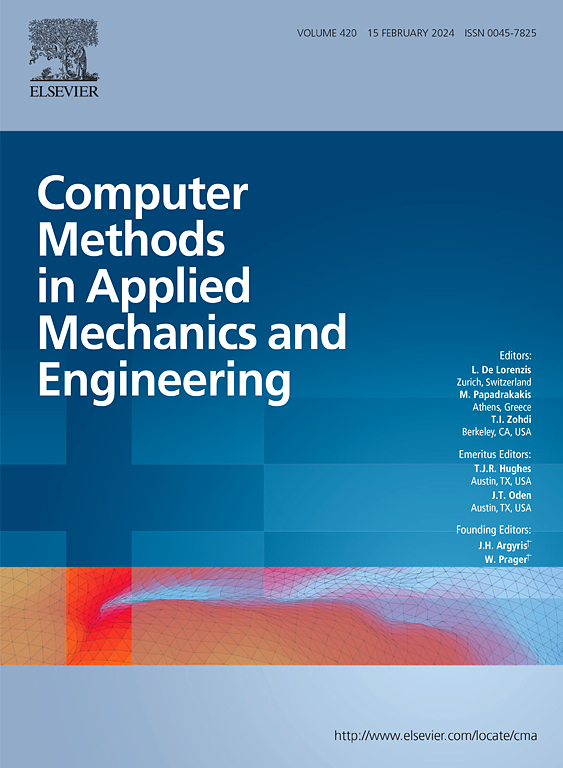Assessing the Capriccio method via one-dimensional systems for coupled continuum-particle simulations in various uniaxial load cases using a novel interdimensional comparison approach
IF 7.3
1区 工程技术
Q1 ENGINEERING, MULTIDISCIPLINARY
Computer Methods in Applied Mechanics and Engineering
Pub Date : 2025-03-07
DOI:10.1016/j.cma.2025.117817
引用次数: 0
Abstract
This contribution investigates sources of insufficiencies observed with the Capriccio method for concurrent continuum-particle coupling using a novel comparison technique. This approach maps the deformation states of three-dimensional (3D) coupled domains into a concise one-dimensional (1D) representation, which allows for a separate evaluation of the domain strains in a unified representation, enabling facile comparisons of the domain states during deformation. For the investigation, we employ both a 1D coupled system resembling the most relevant features of the full 3D Capriccio method as well as a corresponding 3D setup. Our analysis explores interactions between different material models in finite element (FE) and molecular dynamics (MD) domains. Based on various load cases studied in the 1D setup, we identify a resistance of the coupling region to spatial movement as the fundamental cause of strain convergence problems when applying the staggered solution scheme. Using the developed mapping approach, examination of the corresponding 3D setup reveals that these strain inconsistencies are even exacerbated by adverse relaxation effects in viscous MD models, particularly when coupled to a corresponding viscoelastic–viscoplastic FE model, leading to divergence from optimal strain. Our findings confirm that smaller strain increments in combination with larger load step numbers significantly improve strain convergence in all domains. Overall, this indicates the need for detailed sensitivity analysis of coupling parameter influences to reduce the identified motion resistance of the coupling region. Based on promising results in 1D, we further recommend exploring monolithic solving schemes for 3D systems to achieve optimal strain convergence for all types of Capriccio-based coupled particle and continuum material models. Moreover, our systematic approach of system definition and interdimensional comparison may serve as a model to assess other domain-decomposition coupling techniques.

利用一种新颖的维间比较方法,通过一维系统评估在各种单轴载荷情况下耦合连续粒子模拟的Capriccio方法
这贡献调查不足的来源与卡布里西奥方法观察并发连续粒子耦合使用一种新的比较技术。这种方法将三维(3D)耦合域的变形状态映射到简洁的一维(1D)表示中,从而允许在统一表示中对域应变进行单独评估,从而便于在变形过程中对域状态进行比较。在研究中,我们采用了一维耦合系统,类似于全3D卡布里西奥方法的最相关特征,以及相应的3D设置。我们的分析探讨了有限元(FE)和分子动力学(MD)域中不同材料模型之间的相互作用。基于在一维设置中研究的各种载荷情况,我们确定耦合区域对空间运动的阻力是应用交错解决方案时应变收敛问题的根本原因。使用开发的映射方法,对相应的3D设置进行检查表明,粘性MD模型中的不利松弛效应甚至加剧了这些应变不一致性,特别是当耦合到相应的粘弹-粘塑性有限元模型时,导致与最佳应变偏离。我们的研究结果证实,较小的应变增量与较大的加载步数相结合,显著改善了所有域的应变收敛。总的来说,这表明需要对耦合参数影响进行详细的灵敏度分析,以降低耦合区域识别的运动阻力。基于1D中有希望的结果,我们进一步建议探索3D系统的整体求解方案,以实现所有类型的基于capriccio的耦合颗粒和连续介质模型的最佳应变收敛。此外,我们的系统定义和多维比较方法可以作为评估其他领域分解耦合技术的模型。
本文章由计算机程序翻译,如有差异,请以英文原文为准。
求助全文
约1分钟内获得全文
求助全文
来源期刊
CiteScore
12.70
自引率
15.30%
发文量
719
审稿时长
44 days
期刊介绍:
Computer Methods in Applied Mechanics and Engineering stands as a cornerstone in the realm of computational science and engineering. With a history spanning over five decades, the journal has been a key platform for disseminating papers on advanced mathematical modeling and numerical solutions. Interdisciplinary in nature, these contributions encompass mechanics, mathematics, computer science, and various scientific disciplines. The journal welcomes a broad range of computational methods addressing the simulation, analysis, and design of complex physical problems, making it a vital resource for researchers in the field.

 求助内容:
求助内容: 应助结果提醒方式:
应助结果提醒方式:


